#DelosYourself and Undo The Knots in Your Upper Back and Neck
Every morning I wake up with my arms all the way above my head and my ears almost up by my shoulders; it’s the way I’ve slept since I was a little kid. That habit, compounded with years of down dogs and squat thrusters, made my shoulders chronically tight.
No matter what your workout of choice is, tight upper backs are the most common complaint clients have at Delos Therapy according to co-founder Eric Owens.
“It’s mostly tied to sitting at a desk,” Owens commented. “You’re in a hunched position, hands at a keyboard or on a phone, and you’re at that position for eight hours a day.”
What’s more – we’re sitting all day if you really think about it: we sit to eat, commute, watch TV and relax.
As he puts it, our muscles are being trained to stay in that hunched over position; they get less pliable and more hard in that position – enter the knots you feel.
In the first installment of our series with Delos Therapy, Owens breaks down the source of tight muscles and the tools to help ease points of pain. Owens’ father, creator of the Delos Therapy technique, found that it was important to go beyond surface level massage to work deeper into the muscle tissue, at various angles, to break up tightness and restore muscle health.
For all of us (especially me first thing in the morning) with tight necks and upper backs, Owens showed me Delos Therapy method in a few key ways to effectively loosen up those commonly tight areas.
Here’s how to combat your tight neck:

What Delos does: In a chair, your therapist will put you into a “pre-stretch” position with your head tilted down, to expose tightness so he/she can directly work into it.
“We’re not rolling [out the muscle], we’re not stretching it, we’re not massaging it, we’re applying direct pressure to the muscle tissue that feels hard and forcing that tissue to stretch and separate at the location of the pressure,” Owens said.
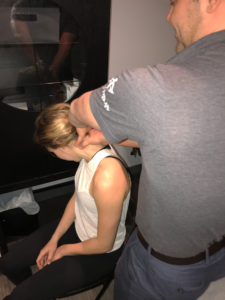
They’ll then deploy the power of the thumbs into the tight spots.
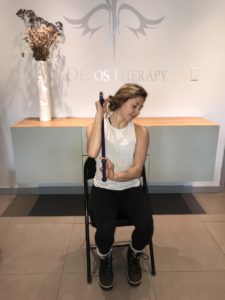
With a Theracane: These tools are built to help you leverage your own strength to apply pressure to tight muscles. To work through neck pain, place the end of the short side of the cane on your neck, and apply pressure forward and down. It hurts so good.
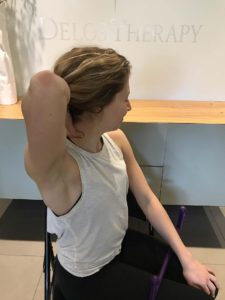
With your hand: Wrap your hand around the back of your neck, thumb around one side and your other fingers around the other side. You’ll apply pressure with your thumb (not your fingers) and you can increase the pressure to a degree you can handle while still maintaining even breath.
To work on tight upper backs:
The rhomboids and trapezius muscles are often big culprits in upper back tightness, Owens explains. As your treating your own muscles, Owens reminds that spot treating won’t do the job.
“Muscles travel far distances. If a muscle is tight it will pull at the attachment point. That attachment point is often very far away from actual tightness. You’ll feel it at a point very distant away from the tightness. So that’s why the entire muscle needs to be treated, from origin to insertion, not just a certain part,” he said.
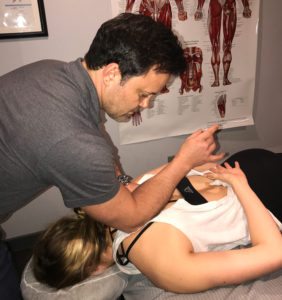
What Delos does: you’ll lie face-down and your therapist will work behind your shoulder blades, even moving your arm behind you to create a pre-stretch that exposes deeper muscles to apply more pressure to them.
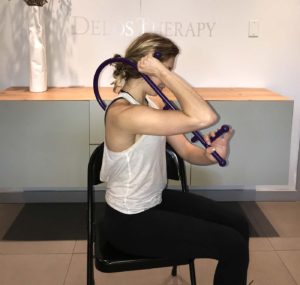
With a Theracane: Place the top knob in an area that feels tight, then position your hands so that you have leverage with downward and outward pressure. Leverage is a big component of what makes the Theracane an effective tool. The more you push down and pull the cane away from your body the deeper the pressure in that targeted point will be.
Hold the Theracane in one spot for a few breaths, then move it an inch or two in one direction, readjust your grip and re-create that downward and outward pressure again. Continue this process around the tightness.
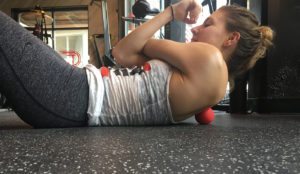
With a lacrosse ball: Lie on your back and place the lacrosse ball under the tight area. Create a stretch by crossing the arm on the same side as the tightness over your body. Hold the lacrosse ball on one spot for a few breaths, then move it an inch or two in one direction and repeat the hold. Continue this process moving up and down the tight muscle, breathing deeply and evenly.
On top of treating tightness when you feel pain, Owens recommends daily maintenance to keep muscles healthy and working to their optimal capacity. Keeping a Theracane or lacrosse ball at your desk and using it throughout the day on your upper back “even just momentarily will help out,” he said.
Questions on how to #DelosYourself or more targeted therapy can be directed to [email protected].












